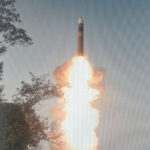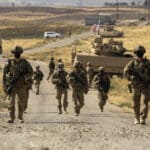The death of the INF Treaty has lessons for arms control
By Amy J. Nelson | November 4, 2019

The Intermediate-range Nuclear Forces (INF) Treaty’s demise is well-documented: the United States formally withdrew from the treaty in August after Russia violated the treaty by developing, testing, and ultimately deploying intermediate-range missiles expressly prohibited by the treaty, and after the United States’ own attempts at persuading Russia to come back into compliance failed. Despite the treaty’s failure, there is much to be learned from its undoing, as well as from the current state of arms control.
It would benefit future leaders and arms control experts to keep three lessons in mind. Thanks in part to the INF’s collapse, and in part to the experience of watching treaties weather and age in the decades after their implementation, we now know that: we should expect weapons technology to continually change—be it by gradual evolution (as in the case of the INF Treaty) or transformative innovation; treaties are likely to be violated in the course of their lifetime and, as such, verification regimes must be designed and implemented in a manner that anticipates this and is useful in managing violations for the treaty’s entire lifespan; and agreements increasingly provide value—or security—as a function of the information they provide. The more access and information a treaty provides, the less likely states will be to withdraw. The INF Treaty lost this value when its verification provisions expired three years after entry into force. Equipped with these lessons, world leaders will be better prepared to think about how to bring the INF treaty—or some version of it—back.
Optimism for arms control. Most recent articles and speeches on arms control smack of nostalgia, teem with regret, or lament its state of crisis. Despite the current climate, however, we are actually in the fortunate position today of having decades of arms control history on which to draw, the benefit of evolving technologies that have already improved verification capacity, and a host of ideas ginned up by experts and analysts. Arms control as a security tool has good scaffolding, but the concepts we layer upon that scaffolding are in need of re-thinking.
No one knows this better than former NATO Deputy Secretary General Rose Gottemoeller. In a refreshing departure from the typical doom-and-gloom analysis, Gottemoeller recently gave a speech about NATO nuclear weapons policy in which she spoke with cautious, informed optimism about arms control in general, and about the idea of a follow-on agreement to the INF Treaty in particular.
In her speech, Gottemoeller highlighted in particular the concept of “the freedom to mix”—to set an absolute limit on missiles for each state, for example, and then allow states to decide which configuration of missiles they will retain toward that limit. This “flexibility” is a feature of the New START Treaty, which allows Russia and the United States to determine their own force structures within ceilings for delivery systems and warheads. The freedom to mix thus allows states to trade off the precision of apples-to-apples comparisons for flexibility and transparency—both of which ultimately stand to increase security and lower uncertainty.
The INF Treaty eliminated all missiles—whether tipped with conventional or nuclear warheads—from Europe entirely, and so lacked this kind of flexibility. Informal discussions in the United States following the ratification of New START examined, among other approaches, the idea of adopting a broadened freedom-to-mix concept as a way to address asymmetric nuclear capabilities that concerned each side. One idea was to set an aggregate ceiling for all residual US and Russian weapons and systems and allow each side to choose how many strategic and non-strategic assets to retain under that ceiling. Given the diversity of capabilities generated by the United States, Russia, and China, further incorporation of such flexibility into future agreements stands to both facilitate the reaching of an agreement and to make any negotiated agreement more robust to violations. (Whether any such agreement increases co-signers’ perception of their own security lays in the balance.)
Gottemoeller also pointed out that the same technology that permitted re-entry vehicle onsite inspection for New START could now be used to verify ground-launched intermediate-range missiles that specifically carry nuclear warheads. Technology to distinguish between intermediate and long-range delivery systems existed at the time the INF Treaty was negotiated, but technology to discern whether intermediate-range delivery systems had nuclear re-entry vehicles was not available. Given the availability of such technology today, the United States and Russia are in a unique position to limit nuclear-only capable missiles—or to “put the ‘N’ back in INF,” as she suggested.
Lessons learned. Gottemoeller’s ideas for an INF follow-on demonstrate a clear belief that arms control today needs to be more flexible and able to adapt to new technologies. As I have argued elsewhere with Dr. Justin V. Anderson, arms control agreements, particularly those without expiration provisions, must be crafted in a way that allows them to evolve. Treaties must be adapted to new weapons technologies throughout the course of their lifetimes. We should not only assume new weapons technologies will come into existence, but design agreements to have sufficient provisions and be rigorously maintained for adjusting to these developments.
Second, at the time the INF Treaty was negotiated, it is possible that agreeing to arms limitations with a previously untrusted adversary provided enough of an increase in security to warrant the legally binding agreement. It is also likely that once obstacles to reaching an agreement, including three years of verification through inspections, were overcome, the idea of violations decades into implementation were beyond the scope of imagination. We know now, however, that arms control treaties are likely to be violated and that standing consultative bodies can serve a vital role in managing and resolving violations and disputes from diverging interpretations. We also know that state-level mechanisms for managing arms control violations are not yet sufficient. There is a great deal more to be done here, namely in understanding and codifying varying degrees of violations and establishing responses that “kick in” almost automatically when a consultative body determines that a threshold has been crossed (much like the Joint Comprehensive Plan of Action’s “snapback” sanctions).
Third, the INF Treaty’s verification provisions for onsite inspections expired 13 years after the treaty’s entry into force, though the agreement itself was designed to be of unlimited duration. As such, the INF treaty decreased in value as it ceased providing information. Our contemporary vantage point reveals that the evolution of arms control has occurred simultaneously—and not coincidentally—with technological strides that can enhance monitoring and verification abilities. As a function of perhaps necessity, design, and the availability of new technologies, arms control increasingly finds its value in the information it provides, not necessarily (or so much) in the limitations it sets. While the INF Treaty was the first to have onsite inspection regimes, the Joint Comprehensive Plan of Action has the most intrusive monitoring provisions of any agreement negotiated to date. Every time this verification bar is moved upward, treaties function better as a tool for increasing security, since offering states greater insight into the arsenals of their adversaries reduces uncertainty.
By highlighting the “freedom to mix” and the value of information from verification, Gottemoeller is, in effect, saying we would do well to broaden the reach and utility of our agreements by making them more flexible and increasing their capacity for providing security-useful information. If we can succeed at this, arms control as a security tool will remain relevant to contemporary security concerns.
Looking ahead. More broadly, however, we will need to consider the value of individual arms control agreements on their own terms, as well as the broader benefits of agreements that may not be achieved all at once but, over time, are designed to work in concert with one another. Gottemoeller’s proposal to negotiate a “nuclear-only” INF Treaty—one that explicitly bans nuclear-capable missies—that also includes China, Russia, and the United States adopts a path-of-least-resistance mentality that could reap benefits decades down the road. It may pave the way for future agreements that could, for example, place limitations on defensive systems or emerging technologies.
This comes with a caveat: if we pursue a nuclear-only agreement (and thus put the “N” back in INF), we will need to consider whether arms control treaties that govern nuclear weapons can remain an effective tool for achieving “strategic stability” given the dynamic, innovative, and uncertain security environment in which we now find ourselves. New destabilizing non-nuclear weapons and technologies stand to tip the balance of power and disrupt whatever equilibrium was achieved previously. Once upon a time, it was easier for the U.S. to adopt a policy of pursuing strategic stability—a balance of nuclear powers—in part through arms control, and the simultaneous development of “offsetting” conventional technologies (as in the Second Offset Strategy) because nuclear and conventional capabilities were, at least conceptually and with respect to potential for causing damage, confined to separate spheres. Today, however, it is not clear that the tension between this simultaneous pursuit of strategic stability and potentially destabilizing novel technologies will be as easily resolved (particularly as these newer technologies “get out”). Thus, the net benefit of a potential nuclear-only agreement may be somewhat diminished in its contribution to strategic stability, although could still serve as a stepping-stone to better times for diplomacy and increased trust.
The long history of arms control is now rich with data that can inform our path forward. A nuclear-only replacement agreement for the INF Treaty stands to provide, at a minimum, the short-term benefit of temporary stability. Any longer-term benefits require the negotiation of a treaty that is sufficiently flexible and dynamic, that anticipates violations, and that affords access to information valuable to security. For the United States, whoever is elected president in 2020 should proceed with this in mind.
The views expressed in this article are those of the author and are not an official policy or position of the National Defense University, the Department of Defense or the U.S. Government.
Correction: The original version of this article incorrectly stated that the INF provided for three years of onsite inspections. Onsite inspections were undertaken for 13 years.
Together, we make the world safer.
The Bulletin elevates expert voices above the noise. But as an independent nonprofit organization, our operations depend on the support of readers like you. Help us continue to deliver quality journalism that holds leaders accountable. Your support of our work at any level is important. In return, we promise our coverage will be understandable, influential, vigilant, solution-oriented, and fair-minded. Together we can make a difference.
Keywords: INF Treaty, arms control, treaty compliance, treaty verification
Topics: Analysis, Nuclear Weapons
















Excellent article. I would also note that “adaptive” arms control strategies would benefit conventional arms control and CSBM arrangements as well. The difference on the conventional side is that building in treaty flexibility must account for dynamic political landscapes and potential conflicts (like nuclear agreements, these are also historically inventoried), requiring special attention to balance legitimate national and regional security requirements among the signatories. The only thing missing for success in both conventional, non-conventional, and nuclear arenas is national political will and leadership. Haven’t seen much of that lately.
Naive article. Arms control treaties between sovereign states by definition have no enforcement mechanisms to redress a Party’s treaty violation(s) other than the political will of the aggrieved Party(ies) (and other third party states) to take such action(s) they deem necessary to secure their interests in the face of the violating Party’s non-compliance. International politics is a dynamic environment subject to ongoing change. Factors both internal and external to a particular State, or multiple state parties to an agreement, change over time in ways that affect the security environment in which they exist. These factors can be economic, political, technological… Read more »